Energy-Related CO2 Emissions Forecasting Using an Improved LSSVM Model Optimized by Whale Optimization Algorithm
Abstract
:1. Introduction
- A novel LSSVM-based CO2 emissions forecasting model is proposed, of which the significant parameters in LSSVM are optimized by the meta-heuristic optimization algorithm WOA. It is verified that this hybrid intelligence forecasting method has the superiority in the forecasting precision of CO2 emissions through comparing with LSSVM model optimized by FOA, LSSVM without parameters optimization and OLS (ordinary least square). This paper extends the application domains of intelligence LSSVM forecasting technique.
- GDP, energy consumption and population, which are considered as the main driving forces of CO2 emissions, are imported into the proposed WOA-LSSVM approach. Therefore, the proposed CO2 emissions prediction model in this paper not only employs the intelligence forecasting technique, but also takes the social economic driving factors of CO2 emissions into consideration, which encapsulates the complicated nonlinear relationships of CO2 emissions with its main driving forces to some extent.
2. The Methodology of WOA-LSSVM Forecasting Model
2.1. Basic Methodology of LSSVM Model
2.2. Basic Theory of WOA
2.3. Basic Principle of WOA-LSSVM Model for CO2 Emissions Forecasting
3. Empirical Simulation and Analysis
3.1. Data Sources and Preprocessing of Data Sample
3.2. Optimal Parameters Determination for LSSVM Method
4. Forecasting Performance Evaluation
4.1. Selection of Comparison Models and Forecasting Performance Evaluation Index
4.2. Comparisons of Prediction Performance for Different Prediction Methods
5. Conclusions
Acknowledgments
Author Contributions
Conflicts of Interest
References
- Suganthi, L.; Samuel, A.A. Energy models for demand forecasting—A review. Renew. Sustain. Energy Rev. 2012, 16, 1223–1240. [Google Scholar] [CrossRef]
- Wang, W.; Kuang, Y.; Huang, N. Study on the decomposition of factors affecting energy-related carbon emissions in Guangdong province, China. Energies 2011, 4, 2249–2272. [Google Scholar] [CrossRef]
- Akbostancı, E.; Tunç, G.I.; Aşık, S.T. CO2 emissions of Turkish manufacturing industry: A decomposition analysis. Appl. Energy 2011, 88, 2273–2278. [Google Scholar] [CrossRef]
- Auffhammer, M.; Carson, R.T. Forecasting the path of China’s CO2 emissions using province-level information. J. Environ. Econ. Manag. 2008, 55, 229–247. [Google Scholar] [CrossRef]
- Safdarnejad, S.M.; Hedengren, J.D.; Baxter, L.L. Dynamic optimization of a hybrid system of energy-storing cryogenic carbon capture and a baseline power generation unit. Appl. Energy 2016, 172, 66–79. [Google Scholar] [CrossRef]
- Gopan, A.; Kumfer, B.M.; Phillips, J.; Thimsen, D.; Smith, R.; Axelbaum, R.L. Process design and performance analysis of a staged, pressurized oxy-combustion (SPOC) power plant for carbon capture. Appl. Energy 2014, 125, 179–188. [Google Scholar] [CrossRef]
- Safdarnejad, S.M.; Hedengren, J.D.; Baxter, L.L. Plant-level dynamic optimization of cryogenic carbon capture with conventional and renewable power sources. Appl. Energy 2015, 149, 354–366. [Google Scholar] [CrossRef]
- Kang, C.A.; Brandt, A.R.; Durlofsky, L.J. A new carbon capture proxy model for optimizing the design and time-varying operation of a coal-natural gas power station. Int. J. Greenh. Gas Control 2016, 48, 234–252. [Google Scholar] [CrossRef]
- Belaissaoui, B.; Cabot, G.; Cabot, M.S.; Willson, D.; Favre, E. CO2 capture for gas turbines: An integrated energy-efficient process combining combustion in oxygen-enriched air, flue gas recirculation, and membrane separation. Chem. Eng. Sci. 2013, 97, 256–263. [Google Scholar] [CrossRef]
- O’Neill, B.C.; Desai, M. Accuracy of past projections of US energy consumption. Energy Policy 2005, 33, 979–993. [Google Scholar] [CrossRef]
- Auffhammer, M. The rationality of EIA forecasts under symmetric and asymmetric loss. Resour. Energy Econ. 2007, 29, 102–121. [Google Scholar] [CrossRef]
- Bohringer, C.; Conrad, K.; Loschel, A. Carbon taxes and joint implementation: An applied general equilibrium analysis for Germany and India. Environ. Resour. Econ. 2003, 24, 49–76. [Google Scholar] [CrossRef]
- Meng, M.; Niu, D. Modeling CO2 emissions from fossil fuel combustion using the logistic equation. Energy 2011, 36, 3355–3359. [Google Scholar] [CrossRef]
- Liang, Q.M.; Fan, Y.; Wei, Y.M. Multi-regional input–output model for regional energy requirements and CO2 emissions in China. Energy Policy 2007, 35, 1685–1700. [Google Scholar] [CrossRef]
- Chen, T.; Wang, Y. A fuzzy-neural approach for global CO2 concentration forecasting. Intell. Data Anal. 2011, 15, 763–777. [Google Scholar]
- Pao, H.T.; Tsai, C.H. Modeling and forecasting the CO2 emissions, energy consumption, and economic growth in Brazil. Energy 2011, 36, 2450–2458. [Google Scholar] [CrossRef]
- Lin, C.S.; Liou, F.M.; Huang, C.P. Grey forecasting model for CO2 emissions: A Taiwan study. Appl. Energy 2011, 88, 3816–3820. [Google Scholar] [CrossRef]
- He, J.K.; Deng, J.L.; Su, M.S. CO2 emission from China’s energy sector and strategy for its control. Energy 2010, 35, 4494–4498. [Google Scholar] [CrossRef]
- Liao, R.J.; Zheng, H.B.; Grzybowski, S.; Yang, L.J. Particle swarm optimization-least squares support vector regression based forecasting model on dissolved gases in oil-filled power transformers. Electr. Power Syst. Res. 2011, 81, 2074–2080. [Google Scholar] [CrossRef]
- Wu, Q. Hybrid model based on wavelet support vector machine and modified genetic algorithm penalizing Gaussian noises for power load forecasts. Expert Syst. Appl. 2011, 38, 379–385. [Google Scholar] [CrossRef]
- Zhou, J.Y.; Shi, J.; Li, G. Fine tuning support vector machines for short-term wind speed forecasting. Energy Convers. Manag. 2011, 52, 1990–1998. [Google Scholar] [CrossRef]
- Wang, S.; Yu, L.; Tang, L.; Wang, S.Y. A novel seasonal decomposition based least squares support vector regression ensemble learning approach for hydropower consumption forecasting in China. Energy 2011, 36, 6542–6554. [Google Scholar] [CrossRef]
- Sulaimana, M.H.; Mustafab, M.W.; Shareefc, H.; Abd-Khalid, S.N. An application of artificial bee colony algorithm with least squares supports vector machine for real and reactive power tracing in deregulated power system. Int. J. Electr. Power 2012, 37, 67–77. [Google Scholar] [CrossRef]
- Dos Santosa, G.S.; Justi Luvizottob, L.G.; Marianib, V.C.; Dos Santos, L.C. Least squares support vector machines with tuning based on chaotic differential evolution approach applied to the identification of a thermal process. Expert Syst. Appl. 2012, 39, 4805–4812. [Google Scholar] [CrossRef]
- Li, H.; Guo, S.; Zhao, H.; Su, C.; Wang, B. Annual electric load forecasting by a least squares support vector machine with a fruit fly optimization algorithm. Energies 2012, 5, 4430–4445. [Google Scholar] [CrossRef]
- Mirjalili, S.; Lewis, A. The Whale optimization algorithm. Adv. Eng. Softw. 2016, 95, 51–67. [Google Scholar] [CrossRef]
- Huang, X.; Shi, L.; Suykens, J.A.K. Asymmetric least squares support vector machine classifiers. Comput. Stat Data Anal. 2014, 70, 395–405. [Google Scholar] [CrossRef]
- Watkins, W.A.; Schevill, W.E. Aerial observation of feeding behavior in four baleen whales: Eubalaena glacialis, Balaenoptera borealis, Megaptera novaean-gliae, and Balaenoptera physalus. J. Mammal. 1979, 60, 155–163. [Google Scholar] [CrossRef]
- Goldbogen, J.A.; Friedlaender, A.S.; Calambokidis, J.; Mckenna, M.F.; Simon, M.; Nowacek, D.P. Integrative approaches to the study of baleen whale diving behavior, feeding performance, and foraging ecology. BioScience 2013, 63, 90–100. [Google Scholar]
- Andresosso-O’Callaghan, B.; Yue, G. Sources of output change in China: 1987–1997 application of a structural decomposition analysis. Appl. Econ. 2002, 34, 2227–2237. [Google Scholar] [CrossRef]
- Peters, G.; Webber, C.; Guan, D.; Hubacek, K. China’s growing CO2 emissions a race between lifestyle changes and efficiency gains. Environ. Sci. Technol. 2007, 41, 5939–5944. [Google Scholar] [CrossRef]
- Guan, D.; Peters, G.P.; Weber, C.L.; Hubacek, K. Journey to world top emitter: An analysis of the driving forces of China’s recent CO2 emissions surge. Geophys. Res. Lett. 2009, 36, 1–5. [Google Scholar] [CrossRef]
- Wang, S.; Yang, J. A probabilistic model for latent least squares regression. Neurocomputing 2015, 149, 1155–1161. [Google Scholar] [CrossRef]
- Amiri, M.; Davande, H.; Sadeghian, A.; Chartier, S. Feedback associative memory based on a new hybrid model of generalized regression and self-feedback neural networks. Neural Netw. 2010, 23, 892–904. [Google Scholar] [CrossRef] [PubMed]
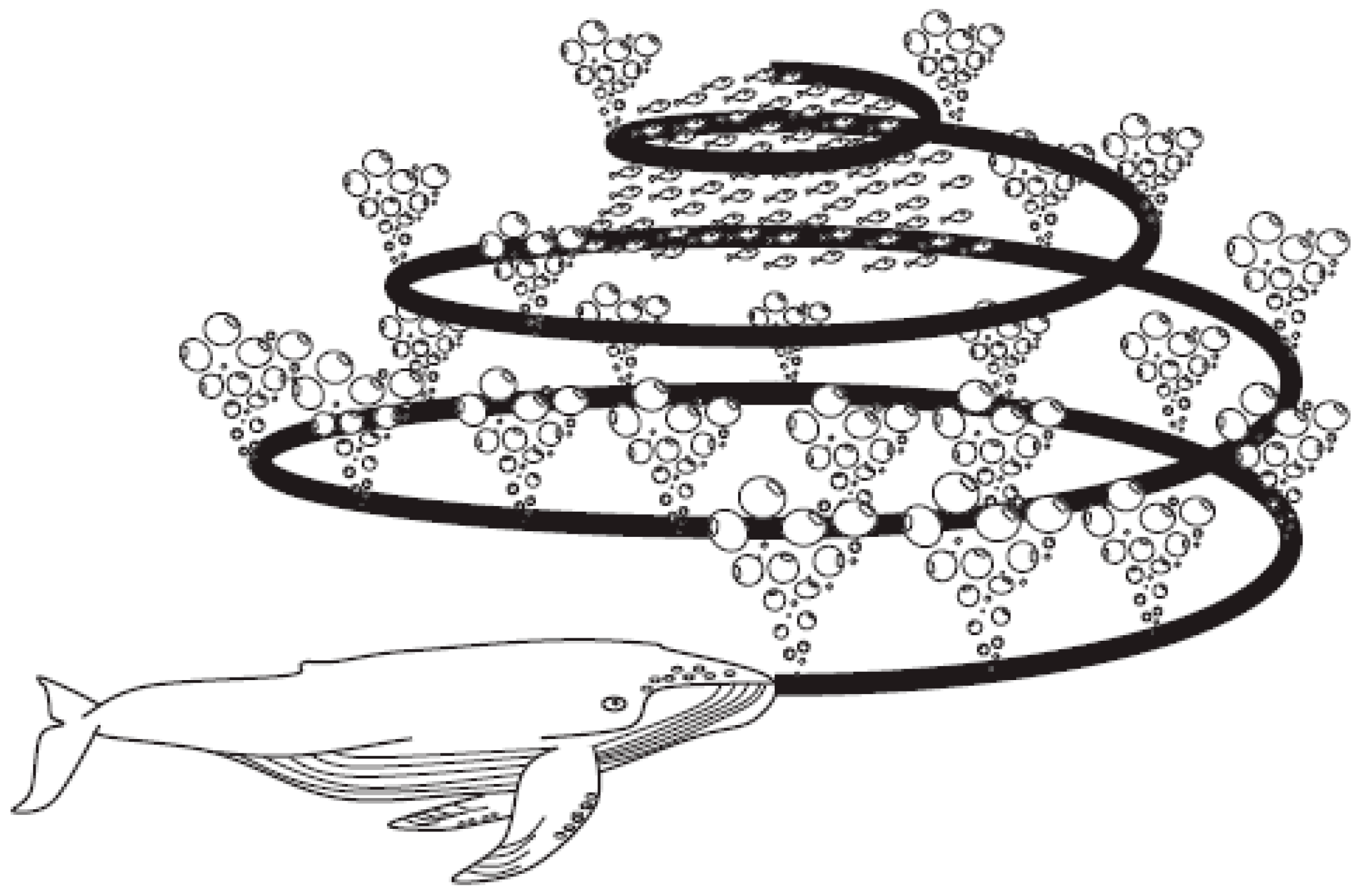

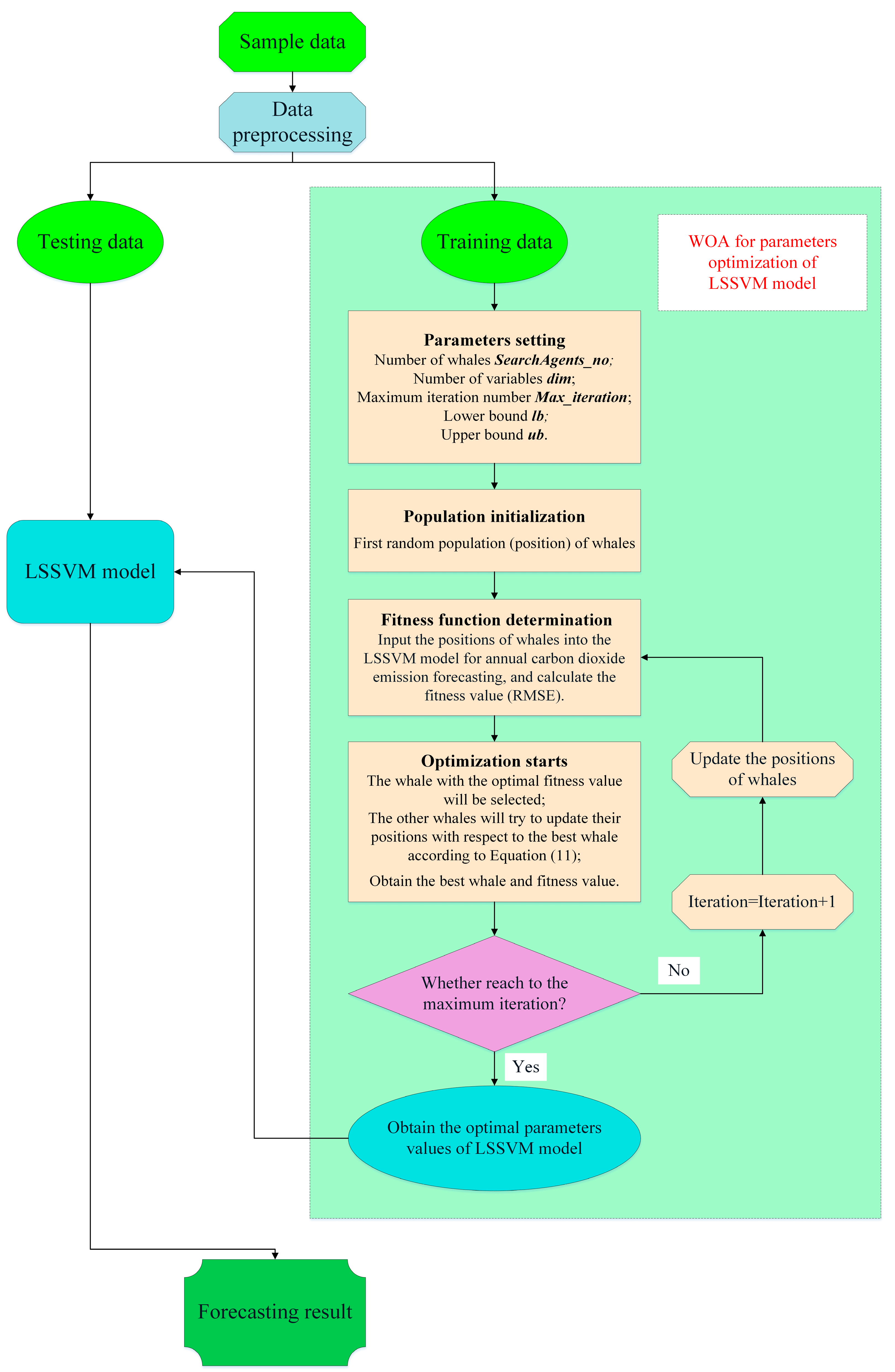
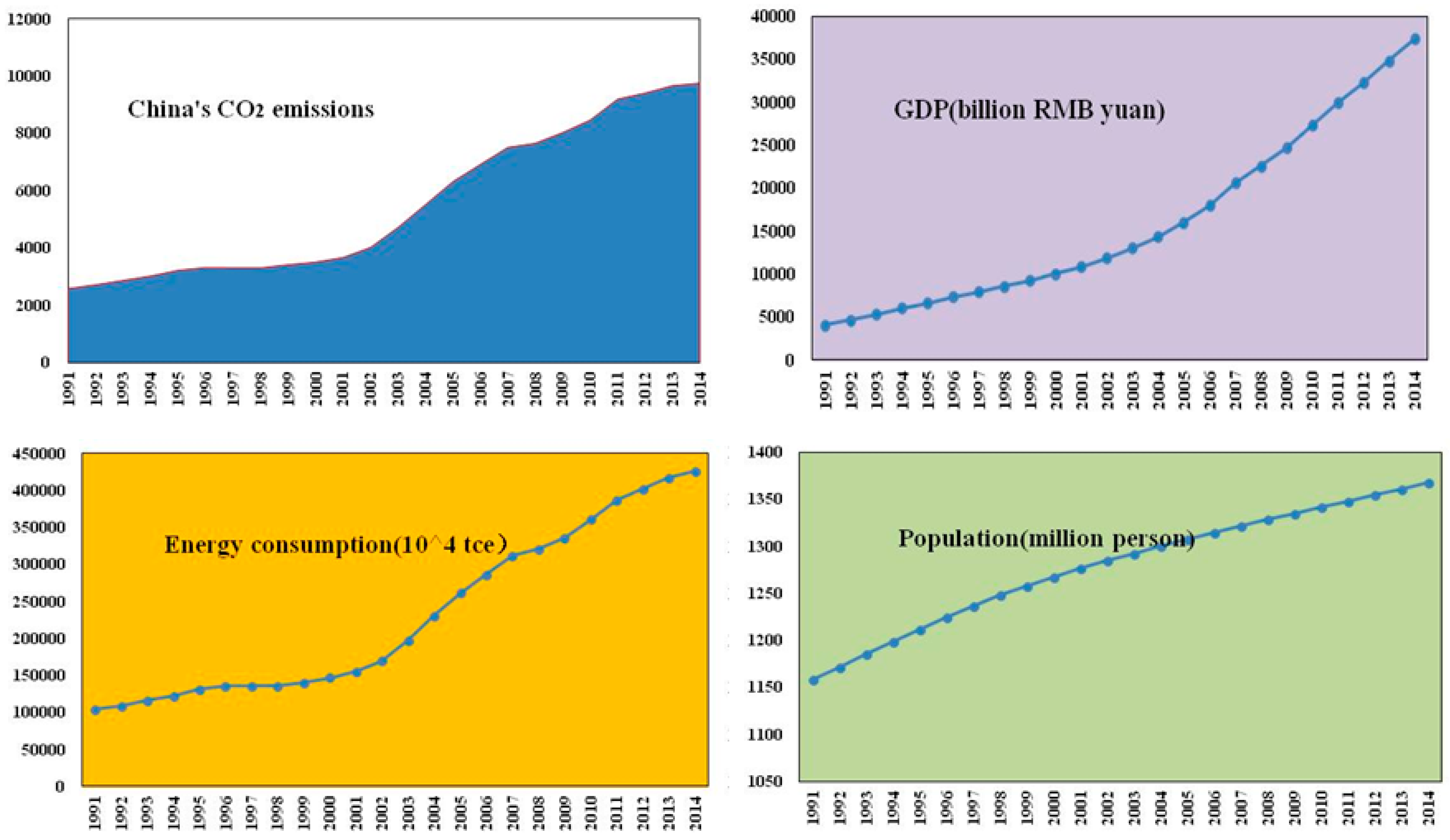
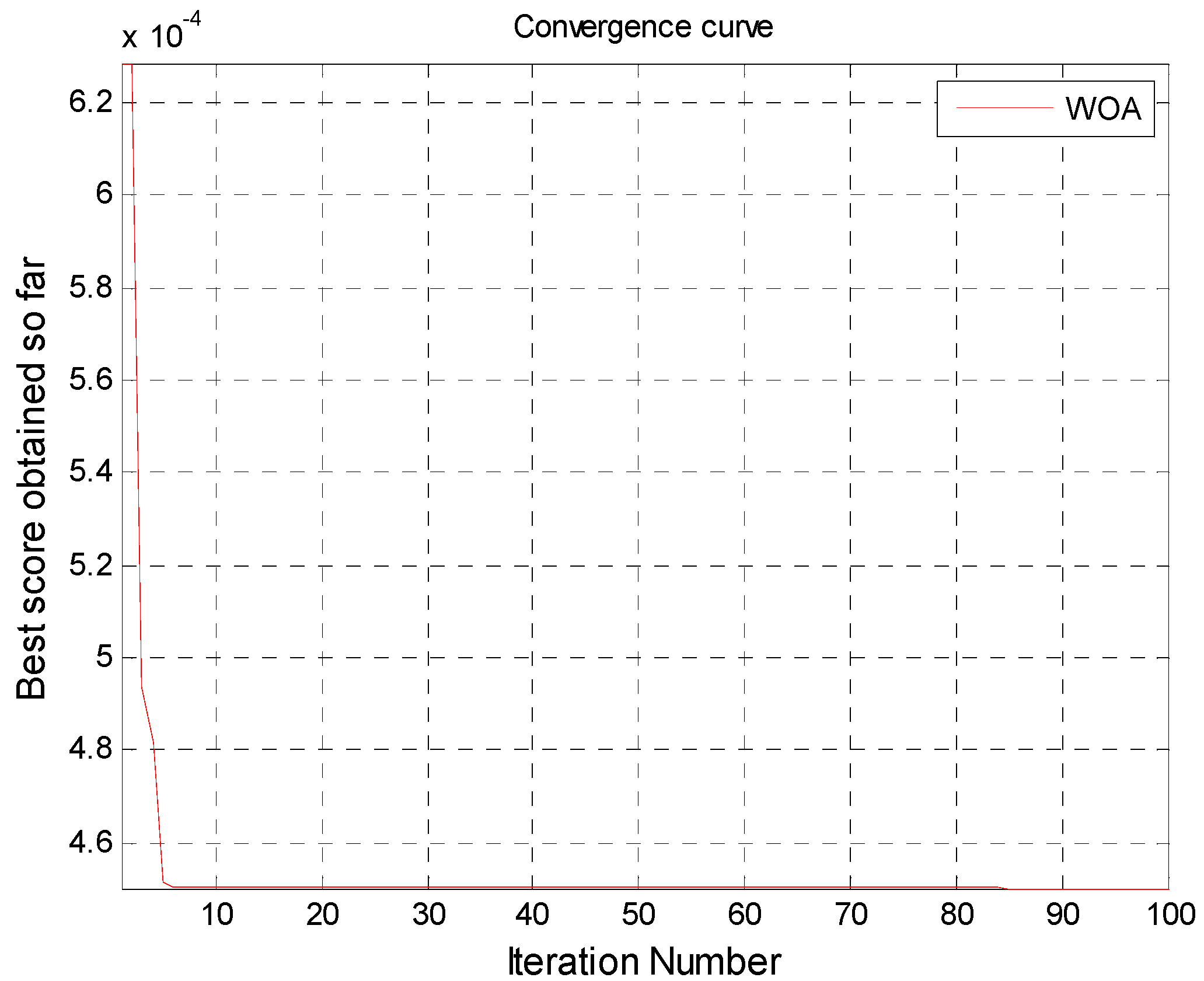

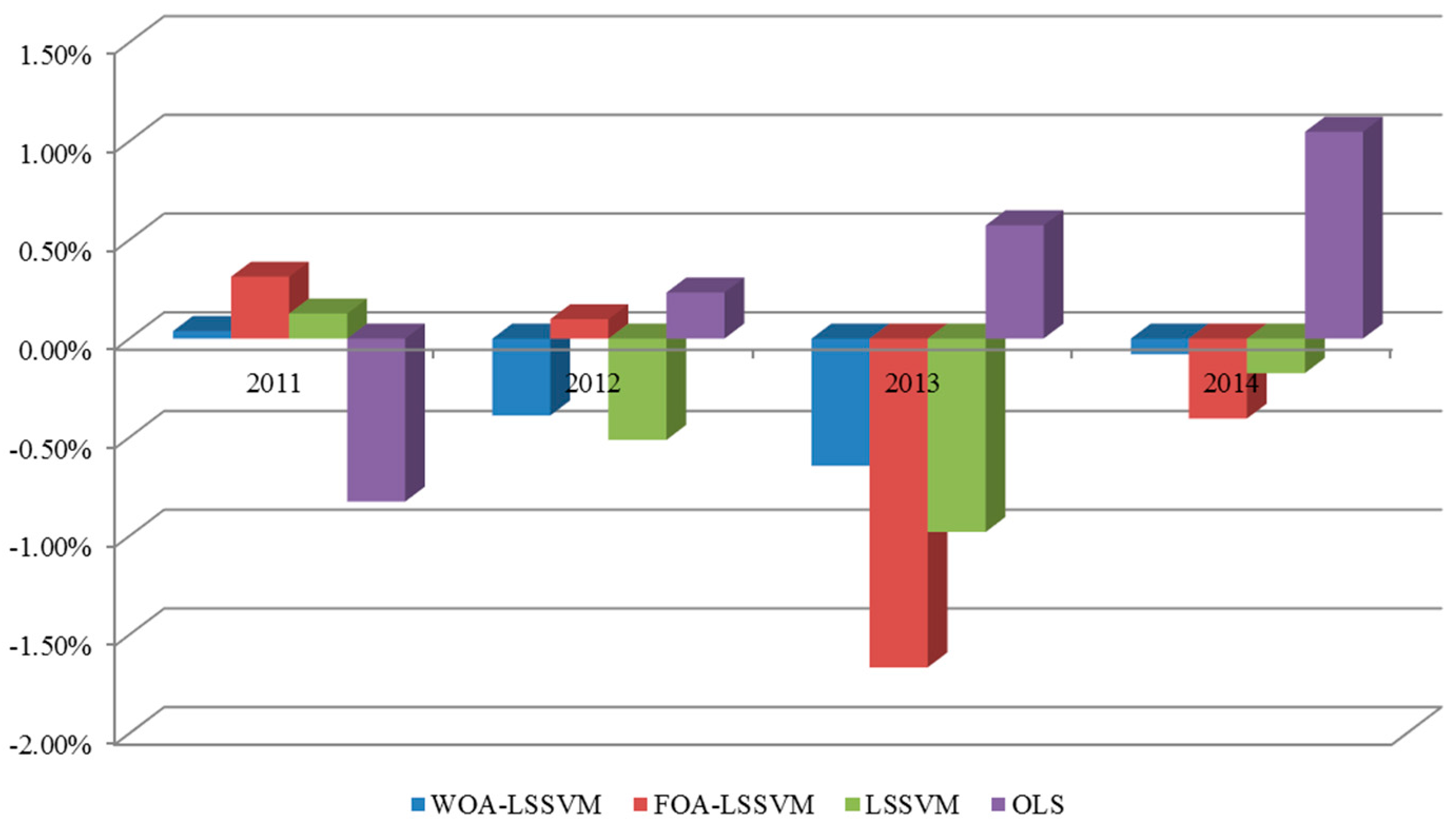
| Driving Forces | GDP | Energy Consumption | Population | Total Export | Economic Structure * |
|---|---|---|---|---|---|
| Correlation degree | 0.6577 | 0.6727 | 0.6798 | 0.6377 | 0.6015 |
| Year | Forecasting Value (Unit: Mt) | Actual Value (Unit: Mt) | The Gap * (Unit: Mt) |
|---|---|---|---|
| 2011 | 9209.67 | 9206.12 | −3.55 |
| 2012 | 9378.71 | 9415.42 | 36.71 |
| 2013 | 9611.85 | 9674.22 | 62.37 |
| 2014 | 9753.36 | 9761.08 | 7.71 |
| Model | FOA-LSSVM | LSSVM | WOA-LSSVM |
|---|---|---|---|
| 0.2496 | 0.8 | 2.0684 | |
| C | 5.6947 | 20 | 93.2203 |
| Model | WOA-LSSVM | FOA-LSSVM | LSSVM | OLS |
|---|---|---|---|---|
| MAPE (%) | 0.29 | 0.62 | 0.45 | 0.67 |
| RMSE (Mt) | 36.43 | 84.34 | 54.20 | 70.36 |
© 2017 by the authors. Licensee MDPI, Basel, Switzerland. This article is an open access article distributed under the terms and conditions of the Creative Commons Attribution (CC BY) license (http://creativecommons.org/licenses/by/4.0/).
Share and Cite
Zhao, H.; Guo, S.; Zhao, H. Energy-Related CO2 Emissions Forecasting Using an Improved LSSVM Model Optimized by Whale Optimization Algorithm. Energies 2017, 10, 874. https://doi.org/10.3390/en10070874
Zhao H, Guo S, Zhao H. Energy-Related CO2 Emissions Forecasting Using an Improved LSSVM Model Optimized by Whale Optimization Algorithm. Energies. 2017; 10(7):874. https://doi.org/10.3390/en10070874
Chicago/Turabian StyleZhao, Haoran, Sen Guo, and Huiru Zhao. 2017. "Energy-Related CO2 Emissions Forecasting Using an Improved LSSVM Model Optimized by Whale Optimization Algorithm" Energies 10, no. 7: 874. https://doi.org/10.3390/en10070874





